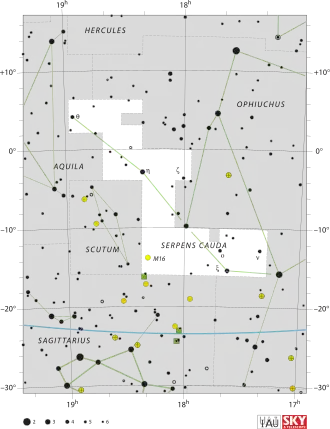PSR J1819–1458
PSR J1819–1458 ist ein Neutronenstern und gehört zur Klasse der Rotating radio transients.[1]
| Pulsar PSR J1819–1458 | |
|---|---|
 | |
| AladinLite | |
| Beobachtungsdaten Äquinoktium: J2000.0, Epoche: J2000.0 | |
| Sternbild | Schlange |
| Rektaszension | 18h 19m 33s [1] |
| Deklination | -14° 58′ 16″ [1] |
| Astrometrie | |
| Entfernung [1] | (12.000) Lj (3.600) pc |
| Physikalische Eigenschaften | |
| Alter | (117.000) a [1] |
| Geschichte | |
| Entdeckung | 2006 |
| AladinLite | |
Eigenschaften
PSR J1819−1458 sendet sporadisch Pulse von Radiowellen aus. Er hat eine Rotationsperiode von 4,26 Sekunden und verlangsamt sich, was für ein starkes Dipol-Magnetfeld (5×1013G, 5×109T) spricht. Die Pulse sind die hellsten aller bisher entdeckten RRATs. Es wird vermutet, dass dieser Pulsar erst etwa 100.000 Jahre alt ist.[1]
Das Objekt hat 3 Emissionsphasen während einer Periode, wobei die stärksten Pulse in der mittleren Phase kommen. Die Puls-Identität ist vergleichbar zu normalen Pulsaren und Giant Pulse Pulsaren, was auf ähnliche Abstrahlmechanismen wie dort deutet.[2]
Auch im Röntgenbereich lassen sich Emissionen um PSR J1819−1458 finden, was als Nebel in der Umgebung interpretiert wird, der seine Energie aus dem Pulsar bezieht.[3] Möglicherweise befindet sich noch ein zweites Objekt im System.[4] Der Pulsar wird mit den Satelliten XMM-Newton und Chandra beobachtet.[5]
PSR J1819−1458 wird seit seiner Entdeckung beobachtet und zeigt Glitches – ein Verhalten das viele junge Pulsare und Magnetare zeigen.[6]
Einzelnachweise
- McLaughlin, M. A.: Transient radio bursts from rotating neutron stars. In: Nature. 439, Nr. 7078, 2006, S. 817–820. arxiv:astro-ph/0511587. bibcode:2006Natur.439..817M. doi:10.1038/nature04440. PMID 16482150.
- Hu, H.-D. et al.: Strong pulses detected from a rotating radio transient J1819-1458. In: Astronomy and Astrophysics. 530, 2011, S. A67. arxiv:1104.3256. bibcode:2011A&A...530A..67H. doi:10.1051/0004-6361/201015953.
- N. Rea et al.: Discovery of extended X-ray emission around the highly magnetic RRAT J1819-1458. In: The Astrophysical Journal Letters. 703, Nr. 1, 2009, S. L41-L45. arxiv:0906.1394. bibcode:2009ApJ...703L..41R. doi:10.1088/0004-637X/703/1/L41.
- N. Rea et al.: Near-infrared observations of rotating radio transients. In: Monthly Notices of the Royal Astronomical Society. 407, Nr. 3, 2010, S. 1887-1894. arxiv:1003.2085. bibcode:2010MNRAS.407.1887R. doi:10.1111/j.1365-2966.2010.17032.x.
- Gaensler, B. M.: Chandra smells a RRAT: X-ray Detection of a Rotating Radio Transient. In: Astrophysics and Space Science. 308, Nr. 1-4, 2007, S. 95–99. arxiv:astro-ph/0608311. bibcode:2007Ap&SS.308...95G. doi:10.1007/s10509-007-9352-8.
- Lyne, A. G. et al.: Unusual glitch activity in the RRAT J1819-1458: an exhausted magnetar?. In: Monthly Notices of the Royal Astronomical Society. 400, Nr. 3, 2006, S. 1439–1444. arxiv:0909.1165. bibcode:2009MNRAS.400.1439L. doi:10.1111/j.1365-2966.2009.15668.x.